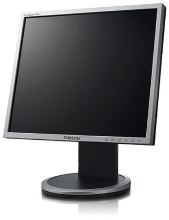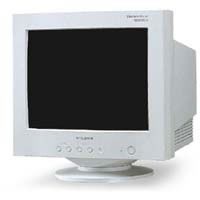How to choose a Monitor?
A Brief Guide
Before we start, here’s a handy tip for when you are purchasing a monitor:
Always buy a monitor that comes with a 30-day return policy. If your monitor is going to breakdown, chances are it will breakdown within a month after purchase.
 |
or
|
 |
There are 2 types of Monitors in the market - CRT (Cathrode Ray Tube) and LCD (Liquid Crystal Display). CRT monitor are those big and bulky beige screen of the past whereas LCD Monitors are the slim and light Monitors that are so popular nowadays. Prices for LCDs have dropped significantly in the past years to make CRT monitor almost obsolete. Some graphic designers still prefer to use CRT as the colour reproduction is 'purer' than LCD. Unless your budget is really tight, do not go for CRT for the many reasons listed below.
| Considerations |
LCD |
CRT |
| Image Flicker |
None |
Prone to flicker |
| Image brightness |
Uniform and bright |
Uneven and variable |
| Image sharpness |
High |
Moderate to high |
| Image geometry |
Uniform |
Distorted |
| Viewable area |
Full area |
Partial area |
| Screen glare |
None |
Prone to glare |
| Energy consumption |
Low |
High |
| Electromagnetic emission |
None |
Yes |
| Heat emission |
Low |
High |
| Space efficiency |
High |
Low |
| Weight |
Light |
Heavy |
| Colour range |
Very good |
Excellent |
| Cost |
Moderate |
Low |
GooGoo Explains
CRT
CRTs are the most common type of Monitor today due to its hundred years of technology head start. The CRT has the same technology as the picture tube inside your TV. CRT Monitors are capable of multiple resolutions, display full-motion video better and provide better colour control over calibration – a crucial point for graphics artists.
But CRTs take up a lot of space, and weigh a lot more than LCDs. Even compact CRTs called short-depth or short-neck Monitors are only a couple of inches shallower than regular CRTs. CRTs are fast becoming passé in modern households though some people still buy them for their good performance at a relatively cheaper price.
LCD
LCDs are fast becoming popular as desktop Monitors as they have the look of newfangled technology. And on top of that, they are slim and light weight. LCDs also require only half the power required for CRTs and they emit much less electromagnetic radiation which can interfere with other electronic devices such as mobile phones.
LCDs have the same display technology as a digital watch in premise, but it is a lot more sophisticated. Each pixel is produced by a tiny cell which contains a layer of liquid crystals. These liquid crystals bend light in response to an electric current.
LCDs are usually clearer than CRTs as they can suffer from convergence or focus problems. This means that smaller LCDs can display higher resolutions than their CRT counterparts. This makes small text easier to read on LCDs. However, LCDs only have one optimal resolution. At lower or higher resolutions, images can look jagged or blocky so make sure the resolution of the LCD you want to purchase is set to its optimal level.
Picking a Monitor
There is really no reason why you should choose a CRT over an LCD unless you are in the design industry. There are also a lot of issues in choosing the right LCD. We will explain the specifications of a LCD to help you make an informed choice.
| Resolution |
e.g 1280 x 1024 - Refers to the number of pixels found on the screen, horizontal by vertical. The higher the resolution, the more data the screen can display at once. |
|
| Dot pitch |
e.g 0.294mm - Refers to the size of a pixel. The lower the number, the crisper the image. |
|
| Response Time |
e.g 8ms - refers to the speed of the liquid crystal changing from one colour to another. The lower the better. |
|
| Brightness |
e.g 300cd/m - refers to the emitted luminous intensity. Higher value means higher onscreen brightness |
|
| Contrast Ratio |
e.g 600 : 1 - refers to the measurement by taking the whitest white against the blackest black. |
|
| Viewing Angle |
This is the angle where viewing the screen from the side. |
|
| Connector |
Digital Video Input (DVI) or Analog - refers to the type of connection between the graphics card and the monitor. Generally, DVI produce sharper images without requiring adjustments |
|
Response time is the time the Monitor takes to change a pixel’s colour. According to Dirk Lorenz of the German Consumer Testing Organization Stiftung Warentest in Berlin, “…there is no set method for measuring [response] time. It’s hard for the buyer to know just which measurements are being used for a given device”.
Therefore, be careful of some marketing gimmicks many companies employ to demonstrate quick response time. For example, it takes a shorter time for a liquid crystal to change from black to white than it takes to change from green to yellow.
Comparing the different response time of liquid crystal between LCD brands is difficult unless the response time stated is for the same colour change. The best way to find out about response time for different LCD Monitors is through hardware reviews that can be found on the internet.
Unless you are a hardcore gamer, a 20 milliseconds response time should be enough. If you play the latest, most demanding games, you will want a response time of at least eight milliseconds.
The two most important factors relating to image quality are contrast and brightness. Go for a Monitor that has a contrast of not less than 450:1 and a brightness of at least 250 candelas per square metre.
GooGoo Recommends
We know we ask you not save on many components that we mentioned but this fact is especially important for a monitor. You can’t upgrade your Monitor and a Monitor, like a Casing, when purchased wisely, can last through several upgrades and end up being the longest serving component for your computer! Therefore, don’t buy a Monitor that does not come with at least a three year warranty.
If your Monitor is frequently going to be viewed by more than one person, get a Monitor with at least 140 degrees horizontal viewing angle to ensure that everyone is happy with a clear picture.
We do not recommend Monitors with integrated speakers. Monitors with integrated speakers may save you space and money but it will not save you from trouble. Beware of salesmen selling you Monitors with integrated speakers on the pretext of saving you money and space. Speakers integrated into LCD Monitors are often of a low quality. Imagine having to lug a Monitor all the way back to a manufacturer just to repair the speakers!
The above guide is provided as a free service to our customers and visitors. All information is written as objectively and accurately as possible. GooGoo Custom Computers are not responsible for any undesirable computer assembly outcomes resulted from reading our hardware guide.


